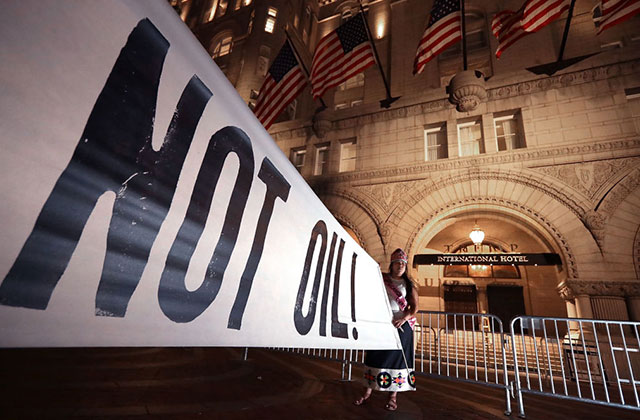Dakota Access Pipeline Sees Its First Spill

The Dakota Access Pipeline (DAPL) isn't yet fully operational, but The Watertown Public Opinion reported today (May 10) that the heavily-protested pipeline has already experienced its first spill.
A surge pump on the DAPL reportedly spilled 84 gallons of crude oil in rural Spink County, South Dakota, back in April. Brian Walsh, an environmental scientist with the state Department of Environment and Natural Resources Ground Water Quality Program, told the local newspaper that Energy Transfer Partners (ETP) reported and cleaned up the spill within the required time, so it won’t face a fine or citation.
ETP spokesperson Vicki Granado told the paper that the spill stayed within the company’s containment area, making it easy to clean. She went on to say that none of the crude oil “actually touch[ed] or hit the soil.”
The surge pump is connected to a tank that is used to store crude oil during regular operation of the line and it physically pushes oil through the line. The pipeline is not yet operational.
Pipeline infrastructure expert Richard B. Kuprewicz told The Watertown Public Opinion that a leak this early may signal that the developer rushed through the construction process. “As far as this happening during the startup, I don’t want to make it sound like a major event, but the fact that you had oil leaving the tank says there’s something not right with their procedures. They might have been trying to hurry.”
ETP attributed the leak to a malfunction during the line fill process, which involves filling the 1,172-mile long pipeline with crude oil before beginning its operations. But Granado did not mention what caused the malfunction or if ETP will launch an internal investigation to find out.
“It shouldn’t happen, but if it did happen, at least it happened in the pump station,” said Kuprewicz. “They need to figure out why this happened.”
Granado told The Watertown Public Opinion the pipeline should be in service by June 1 as the company wraps up this line fill process.
Now, pipeline opponents—who built an extraordinary movement in North Dakota to contest the energy project—are taking to Facebook and calling out ETP for the spill, as well as how long it took for them to hear about it.
Joye Braun, a member of the Cheyenne River Sioux Tribe who played a major role as “water protector” during the #NoDAPL protests, wrote on Facebook today: “[The spill happened] in April, and we are just finding out. [The pipeline] is evil.”
Dallas Goldtooth, campaign organizer with the Native-led environmental justice organization Indigenous Environmental Network, kept it straightforward in his Facebook post: “The FIRST leak on the Dakota Access pipeline has ALREADY OCCURRED.”
Since the beginning, the Standing Rock Sioux Tribe has been clear about its concerns regarding what a spill could do to local drinking water and sacred sites. The conversation has always been about when the pipeline leaks, not if. InsideClimate News reported today that ETP has no oil spill response plan for the portion of the pipeline with which opponents were most concerned: the place where the pipeline crosses the Missouri River. It'll be a year until the company is required to keep emergency response equipment stored near the crossing too, according to documents obtained by the website.
News of this spill comes on the heels of an ETP violation in Ohio. According to The Columbus Dispatch, the Ohio Environmental Protection Agency issued an order on May 5 for the company to pay $431,000 for violations related to the Rover Pipeline, a $4.2 billion interstate natural gas pipeline that will cross 713 miles through Ohio, West Virginia and Pennsylvania.
